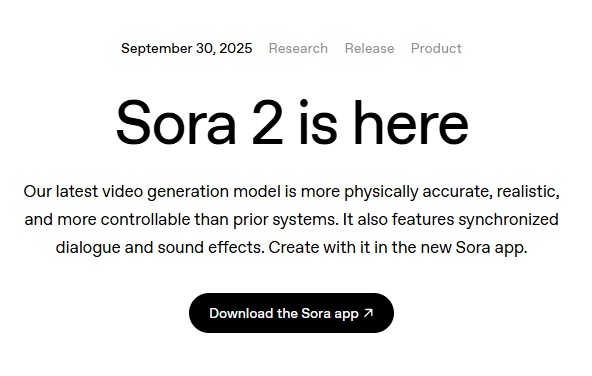Sora 2 is rapidly emerging as a groundbreaking tool in AI-driven video generation, capturing the attention of tech professionals worldwide. Its relevance stems from revolutionary advances in AI capabilities, notably native audio synchronization and improved physical realism, making it a potent resource for creative industries, marketing, and multimedia production. As a product of OpenAI, Sora 2’s innovative features and potential for high-fidelity content creation position it as a leader in AI video technology.
Overview: Brand, Design, and Purpose
OpenAI’s Sora 2 is both a sophisticated machine learning model and an integrated ecosystem designed for seamless video production from text prompts. The platform includes an invite-only iOS app, a web interface, and plans for a developer API. Its main purpose is to enable users to generate highly realistic videos with synchronized audio, maintaining scene continuity across multiple shots, all with minimal effort—aiming to transform content creation workflows.
Key Features of Sora 2
Native Audio Synchronization
One of Sora 2’s most significant breakthroughs is its ability to generate coordinated audio—dialogue, background sounds, and effects—directly alongside visual content. This eliminates the need for manual sound editing post-production, vastly speeding up workflows.
Improved Physical Realism and Multi-Shot Consistency
Sora 2 demonstrates a better understanding of physical laws and scene continuity, with models capable of producing scenes where objects behave realistically—for example, balls bouncing and characters obeying physics. It also maintains consistent character appearances and scene settings across multiple shots, which is vital for storytelling and branding.
Realistic Error Simulation
Unique among video models, Sora 2 can produce scenes incorporating realistic mistakes or failures, such as falls or missed shots, providing more authentic and diverse content creation possibilities. This feature is valuable for creating training scenarios, simulations, or dynamic storytelling.
Advanced Scene Control and Stylistic Range
Creators can request specific camera angles, styles, and artistic approaches, whether cinematic, surreal, or anime. The platform supports a broad stylistic palette, along with remixing options that foster social collaboration and creative experimentation.
Consent and Ethical Safeguards
Sora 2 integrates consent protocols enabling users to insert themselves or others into scenes with verified likenesses, along with options to revoke or restrict use. It emphasizes responsible AI use by blocking explicit content and enabling authentication controls.
User Experience: Design and Usability
OpenAI has prioritized creating a seamless, intuitive interface, allowing users to produce complex videos from simple prompts. The web platform and mobile app work harmoniously, offering a highly personalized experience where users can effortlessly craft multi-scene videos, adjust styles, and preview results. Despite the sophistication internally, the design emphasizes user-friendly interaction—though the underlying complexity necessitates careful handling to avoid ethical pitfalls.
Performance: Real-World Use and Comparisons
In practical scenarios, Sora 2 excels at delivering high-fidelity videos with notable scene continuity and sound synchronization, outperforming earlier AI models and competitors like Veo 3 or Meta Vibes in realism and multi-shot coherence. However, some limitations, such as occasional inconsistencies in spatial geometry or unnatural character movements, have been observed, especially during more complex scenes involving rapid motion or intricate physics. Comparatively, traditional video editing or CGI workflows still hold an edge in precision but are considerably more labor and time-intensive.
Pricing and Value: Is It Worth It?
OpenAI’s initial offering includes a free invite-only version, with premium plans expected to follow—potentially on a usage-based pricing model such as per-minute video generation or token-based billing. Current estimates and comparative analyses suggest that, for creative professionals or large-scale productions, Sora 2 offers compelling value considering the speed, flexibility, and quality of outputs. The upcoming API and tiered plans are likely to cater to both individual creators and enterprise needs, making the overall investment highly justifiable for those leveraging high-quality video content.
Pros and Cons
| Pros | Cons |
|---|---|
| Seamless integration of video and audio | Occasional scene inconsistencies under complex scenarios |
| High realism with scene continuity | Ethical considerations regarding deepfake capabilities |
| Diverse stylistic options | Potential high costs for extensive use |
| User-friendly interface | Still evolving, with some limitations in physics accuracy |
| Strong consent and safety features | Accessibility limited initially to invite-only users |
Ideal Buyers: Who Benefits Most?
Sora 2 is best suited for creative agencies, content creators, marketers, and entertainment professionals seeking rapid, high-quality video content. Its ease of use encourages experimentation, making it ideal for social media campaigns, storytelling, and prototype development. R&D teams in AI and multimedia fields will also find it valuable for testing new narratives or interactive scenarios.
Final Verdict: Summary and Recommendation
Sora 2 marks a significant step forward in AI-generated video technology, combining realism, user-centered design, and advanced scene control. While still maturing, its core features already demonstrate enormous potential for transforming content creation workflows. Tech professionals should consider Sora 2 as a powerful tool for accelerating video production, especially when high fidelity and interactive capabilities are priorities. However, they should remain mindful of evolving ethical and cost considerations.
Conclusion: Key Takeaways and Call-to-Action
In sum, Sora 2 exemplifies the future of AI-driven multimedia. Its ability to generate synchronized audio, maintain scene continuity, and enable creative remixing positions it as a vital resource for innovative content workflows. Tech professionals interested in cutting-edge AI video tools should explore further, monitor updates, and consider early adoption to stay competitive in a rapidly evolving visual content landscape. Interested users are encouraged to access OpenAI’s platforms and stay tuned for upcoming pricing and API options.



 Facebook
Facebook
 LinkedIn
LinkedIn
 X
X
 Reddit
Reddit